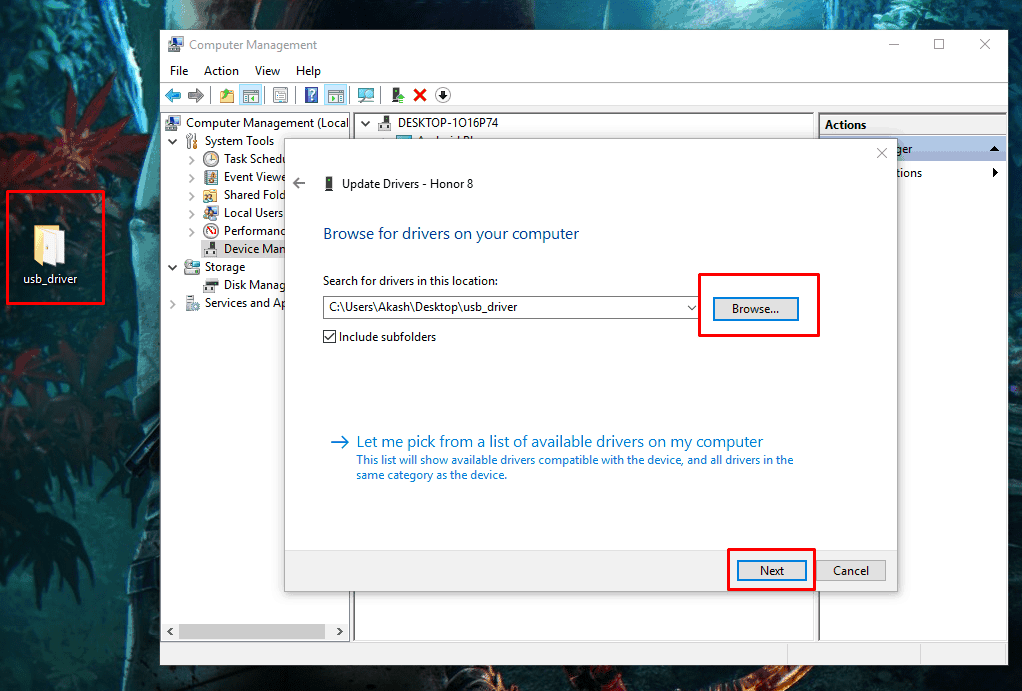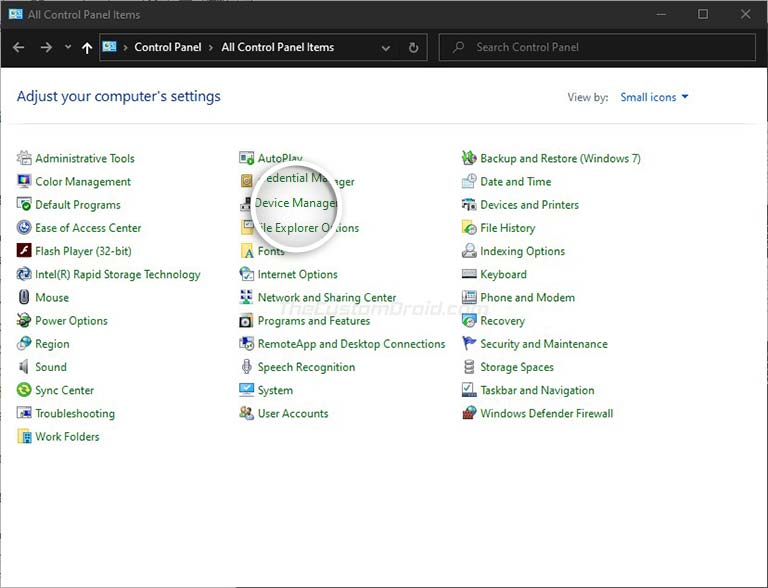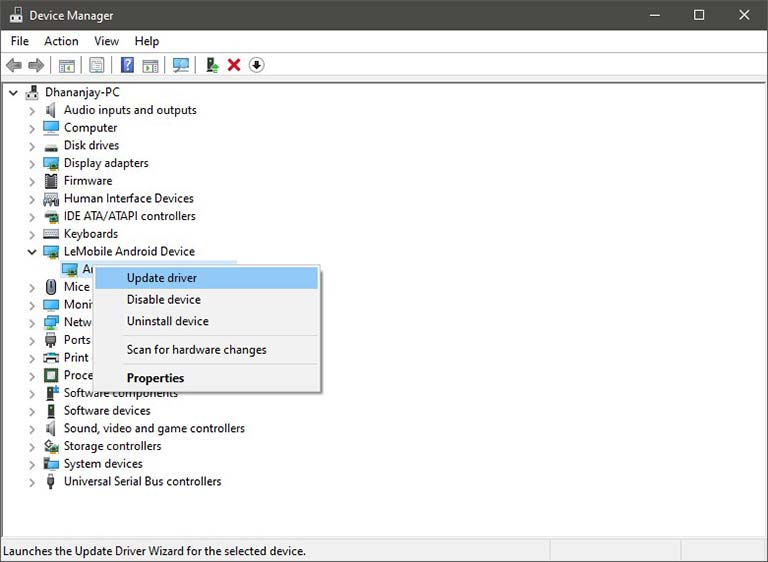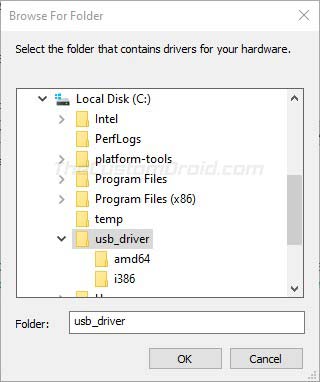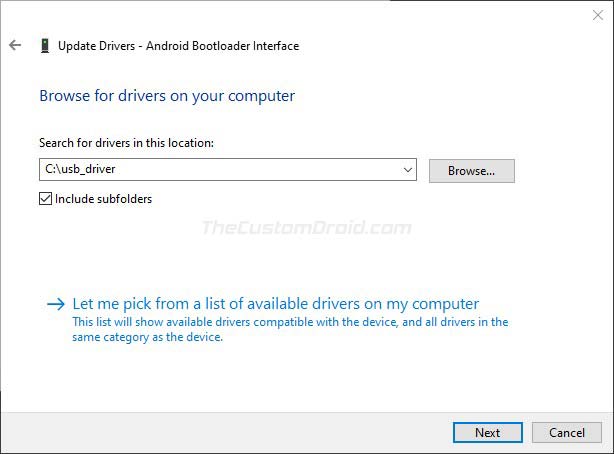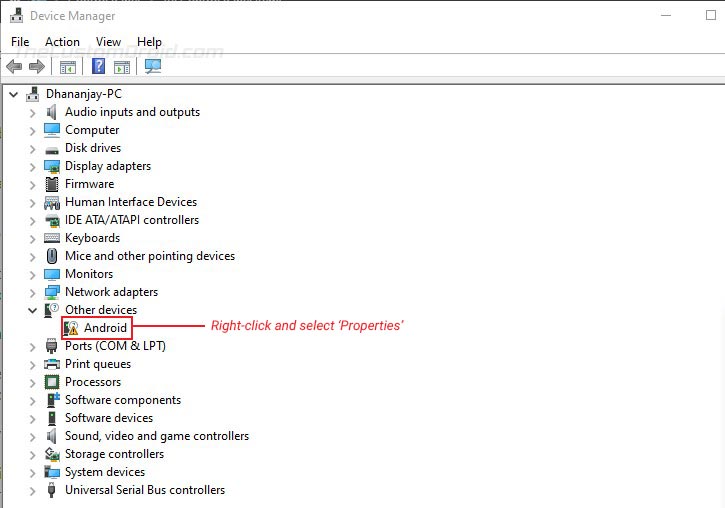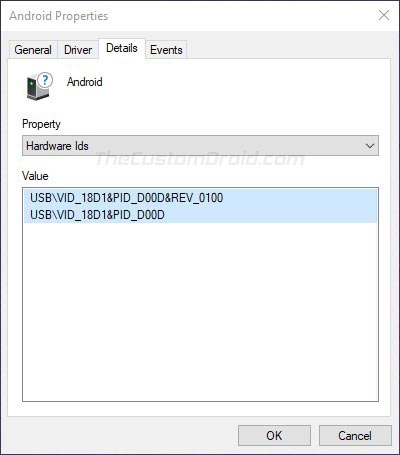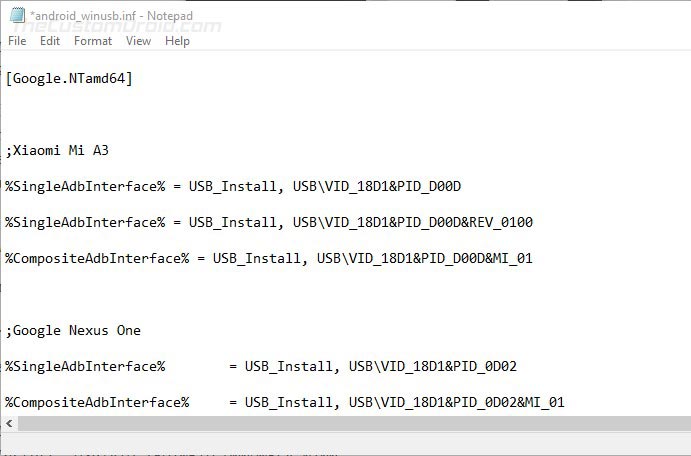Android USB Driver is most important to connect your device with the computer. If your smartphone doesn’t detect your computer then read the article below to fix USB problems. Download Google USB Drivers to connect a Pixel or Nexus Android device with a Windows PC. This Google USB driver package will help you to connect your Pixel or Nexus device which is on Android Debugging Mode. Here we share to download and install the latest version of Google USB Drivers on Windows 11, Windows 10, and Windows 7.
Google USB Drivers For Windows:
If you love to customize your Android device. If you have been with the Android family for a long then know that if you want to customize your device then need to install Custom Recovery like TWRP or need to Root your device. So before going through all those steps, first need to unlock the bootloader of your Android device. Android smartphone needs to be connected to a computer to unlock the bootloader. The Android device’s connection to the computer needs to be correct so that the communication between the two devices is properly. To confirm whether this connection is correct or not need to install proper Android USB Drivers on Windows.
Android USB Drivers For Windows:
Here we provide the latest Google USB Drivers for Windows and also guide you on how to install Google USB Driver on your computer so that the Android device can connect with the computer. This Google USB Driver ware was released for Google Pixel or Google Nexus smartphones. Google USB Driver package mainly works with Google Pixel or Google Nexus Phones but it actually works smoothly with most android devices.
If you have ever installed the OEM android driver on your computer, you are not able to detect your device then you should follow this guide. Through this complete guide, we have solved your phone’s ADB and Fastboot problems for detecting with the computer.
LATEST_USB_DRIVER_WINDOWS.ZIP
Install Google USB Driver on Windows 10:
- First, connect your Android device to the computer via USB cable.
- Right-tap the bottom-left corner, or press Windows+X > Computer Management.
- After opening the Computer, Management clicks on Device Manager from the left panel.
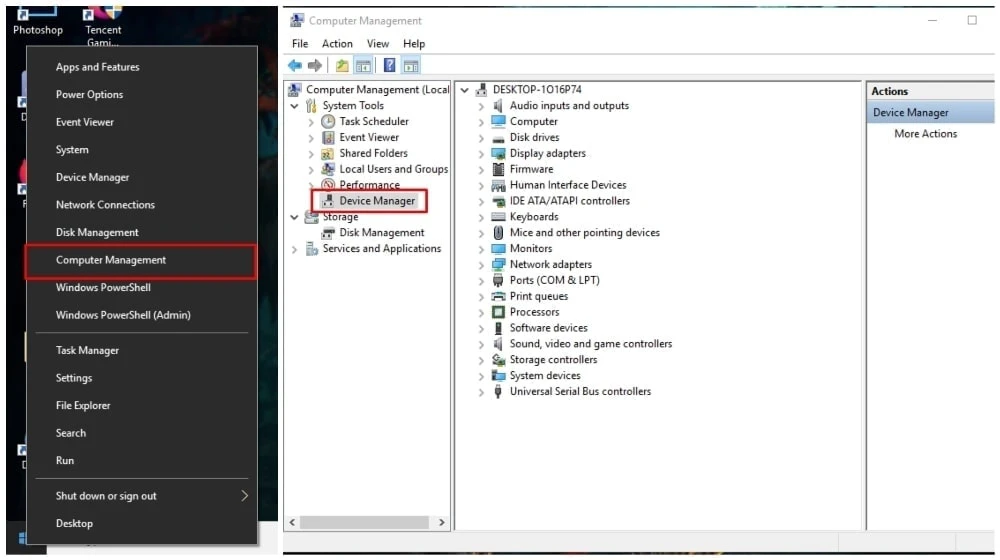
- In the Device Manager > locate and expand Portable Devices from the right panel.
- In Portable Devices, right-click on the device name, and then select Update Driver Software.
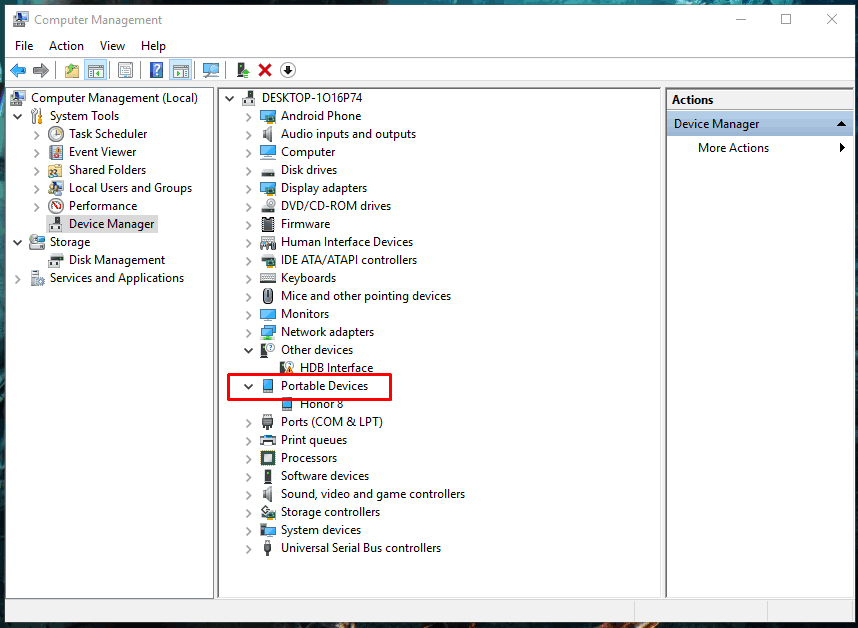
- A popup box will show now click on the “Browse my computer for driver software“.
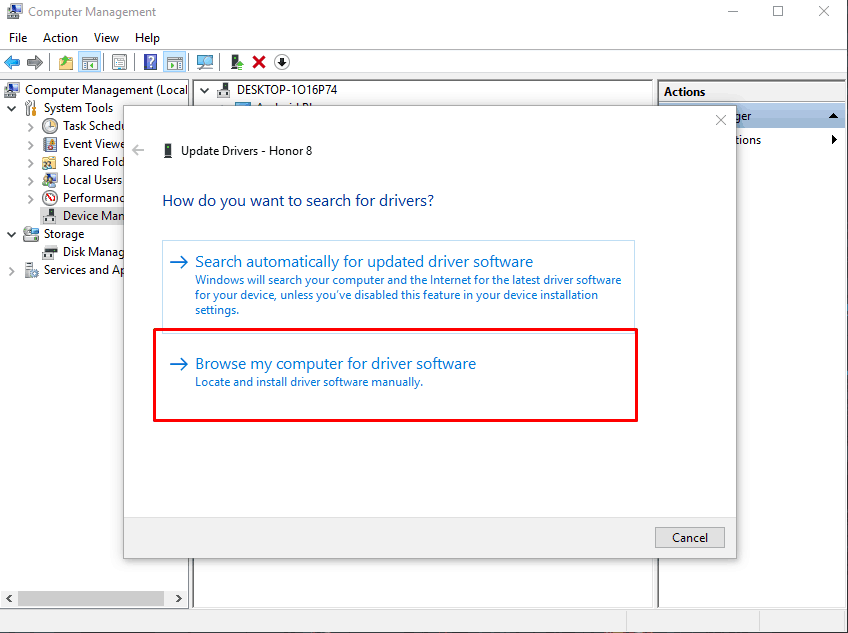
- Click on browse and then locate the Google USB Drivers folder that you download before.
- Now click Next to install the driver.
Install Google USB Driver on Windows 11/Windows 8:
- First, connect your Android device to the computer via USB cable.
- Right-tap the bottom-left corner, or press Windows+X > Computer Management.
- After opening the Computer, Management clicks on Device Manager from the left panel.
- In the Device Manager,> locate and expand “Other devices” from the right panel.
- In Portable Devices, right-click on the device name, and then select Update Driver Software.
- A popup box will show now click on the “Browse my computer for driver software“.
- Click on browse and then locate the USB driver folder that you download before.
- Now click Next to install the driver.
Note: The process more or less the same as Windows 10 driver install method, so if you face problem then see Windows 10 screenshot from the above method.
This was the entire guide to installing Google USB Drivers. Hope these instructions assist you well. If you consider contributing anything to this page, please feel free to write in the comment section below.
Google USB Drivers are required to connect Google Pixel or Nexus devices to Windows PC using a USB cable. You will need these drivers to transfer files or sync data on your Pixel/Nexus device, and especially when working with the Android ADB and Fastboot tools.
You can download the latest Google USB Drivers from here and follow the instructions on how to manually install them on your Windows PC. Furthermore, we have also provided instructions on how to modify the ‘android_winusb.inf‘ file included in the drivers to support other Android devices.
Normally, the said USB drivers come bundled with SDK Manager in the Android Studio IDE, which is constantly updated with the latest available drivers. But if you’re an average Android user, chances are that you might not have the IDE set up on your PC. That’s because it is used mostly by experienced developers and enthusiasts. In that case, you can use the standalone USB drivers, which as provided directly by Google for users who might face issues of Windows not recognizing their phone over a USB connection.
Google USB drivers also act as ‘Android ADB and Fastboot Drivers‘ that allow your computer to communicate with your Android device over the Android Bootloader Interface (Fastboot Mode) as well as Android Composite ADB Interface. So you can install them on your PC to use ADB (Android Debug Bridge) for debugging apps and ROMs, boot your device into Bootloader/Recovery modes, or use Fastboot to unlock the bootloader and flash factory images on your Pixel/Nexus device.
To sum up, the drivers are useful in various situations. With that in mind, go ahead to download the latest version of the USB Drivers from below and follow the instructions on how to install them on your Windows PC.
Table of Contents
- Download Google USB Drivers
- Direct Download
- Download via Android Studio
- How to Install Google USB Drivers
- On Windows 11 and Windows 10
- On Windows 7 and Windows 8/8.1
- How to Modify Google USB Drivers to Support Other Android Devices
- Step 1: Get the VID and PID of your Android Device
- Step 2: Modify ‘android_winusb.inf’ file
- Step 3: Install the Modified USB Drivers
Download Google USB Drivers
Now, there are two different ways/methods to download the USB driver on Windows. You can either download the Google USB Driver ZIP file manually. Or, you can use the SDK Manager in the Android Studio to download it.
The latter gives an added benefit, that is the SDK Manager will automatically notify you when a newer version is available. The former method, on the contrary, will require you to manually check if a newer driver version is available and download it again.
In our personal experience, downloading the ZIP package directly is easier than using the Android Studio. But the choice is solely up to you. We have covered both the methods below.
Note: If you’re using macOS or Linux, you would not need these drivers.
Direct Download
Just click on the link below to download the Google USB Driver ZIP file to your PC.
- Latest version: usb_driver_r13-windows.zip
- Previous versions:
- usb_driver_r12-windows.zip
- usb_driver_r11-windows.zip
- usb_driver_r10-windows.zip
Once downloaded, extract the ZIP file to a suitable location on your computer. The extracted ‘usb_drivers’ folder should contain the required ‘android_winusb.inf’ driver file.
Download via Android Studio
First of all, make sure that you have downloaded and installed the latest version of Android Studio on your Windows PC. Once you have it installed, follow the instructions below:
Android Studio will now download the Google USB drivers to ‘android_sdkextrasgoogleusb_driver‘ on your PC. Here ‘android_sdk‘ is the folder where the Android SDK is installed on your PC.
How to Install Google USB Drivers
The Google USB Drivers come in the form of an ‘android_winusb.inf‘ setup information file, rather than a Windows executable. So, you will need to manually install it on your Windows PC. The same steps can also be used to upgrade the existing drivers installed on your PC to the latest version available.
Now follow the installation guide below according to the Windows OS version you’re using. It’s quite easy and wouldn’t take more than a minute to install them.
On Windows 11 and Windows 10
To install Google Android USB Drivers on Windows 10, follow the instructions below.
- First, connect your Android device to the PC’s USB port.
- Go to the ‘Control Panel‘ and click on ‘Device Manager‘.
- Double-click on your device category to expand the list of connected devices.
- Right-click on your Android device’s name and click on ‘Update driver‘.
- Click on ‘Browse my computer for driver software‘ in the Hardware Update wizard.
- Click ‘Browse‘ and select the ‘usb_driver‘ folder.
- For example: If you downloaded the drivers using Android Studio, the folder should be located in ‘android_sdkextrasgoogle’ on the PC. Or, if you downloaded the ZIP file, then just locate the extracted ‘usb_driver’ folder.
- For example: If you downloaded the drivers using Android Studio, the folder should be located in ‘android_sdkextrasgoogle’ on the PC. Or, if you downloaded the ZIP file, then just locate the extracted ‘usb_driver’ folder.
- Finally, click ‘Next‘ to install the drivers.
On Windows 7 and Windows 8/8.1
To install Google Android USB drivers on Windows 7, Windows 8, and Windows 8.1 PC, follow the instructions below.
- First, connect your Android device to the Windows PC’s USB port.
- Then right-click on ‘Computer‘ and select ‘Manage‘.
- Select Devices in the left pane.
- Double-click on ‘Other device‘ in the right pane to expand it.
- Right-click on the device name (e.g. Google Pixel) and select the ‘Update Driver‘ option.
- Click on ‘Browse my computer for driver software‘ in the Hardware Update wizard.
- Click ‘Browse‘ and locate the ‘usb_driver’ folder.
- Finally, click on ‘Next‘ to install the USB drivers.
You should now have the Google USB Drivers installed. Your Windows PC should now detect and recognize your Android device over the USB connection.
Important Note
If the drivers fail to install even after following the steps, OR the ADB/Fastboot commands do no work even if the drivers are installed, then it could be because you’re using a USB 3.0/3.1/3.2 port or an AMD based PC. This is an issue faced by a lot of users recently.
To fix it, simply try using a USB 2.0 port (If it’s not available, you can also use a USB 2.0 hub) on your PC. Also, try using an Intel-based PC for especially when using ADB/Fastboot tools.
How to Modify Google USB Drivers to Support Other Android Devices
Like we mentioned above, Google USB Drivers also work as ‘ADB Drivers’. But by default, they only support the Google Pixel and Nexus devices.
While Android OEMs do provide their own drivers, but it’s more often than they miss to include the required ADB USB drivers in them. In such cases, you can easily modify the ‘android_winusb.inf’ file in Google USB Drivers to support any other Android device to use the ADB and Fastboot tools.
In order for the drivers to support your non-Pixel/Nexus device, you will first need to acquire the Vendor ID (VID) and Product ID (PID) of your device. Once you have them, the second step is to edit the ‘android_winusb.inf’ file and add a new device section with the VID and PID of your own device. And finally, the third and last step is to install the modified drivers.
Sounds confusing? It’s quite simple actually. Just follow the step-by-step instructions below.
Step 1: Get the VID and PID of your Android Device
- First, connect your Android device to the PC using the USB cable.
- Go to ‘Control Panel‘ > ‘Device Manager‘ on the PC.
- Locate your unrecognized Android device. An unrecognized device can normally be located under the ‘Universal Serial Bus controllers‘ OR ‘Other devices‘ sections in Device Manager. You would see a yellow-colored triangle warning icon beside the connected device.
- Right-click on the device name and click on ‘Properties‘.
- Go to the ‘Details‘ tab and select ‘Hardware Ids‘ from the dropdown menu.
- You should now see the Vendor and Product IDs of your Android device.
Step 2: Modify ‘android_winusb.inf’ file
Now that you have the required IDs, you can modify/edit the ‘android_winusb.inf’ file to add your device to the supported list.
- First, locate the ‘usb_driver‘ folder on your PC. Inside the folder, you should have the ‘android_winusb.inf‘ file.
- Open the file using a text editor and locate the ‘[Google.NTx86]‘ section if your Windows PC is 32-bit (x86) or the ‘[Google.NTamd64]‘ section if your Windows PC is 64-bit (x64).
- In the said section, you will see a number of items with the following format:
;[device name] %SingleAdbInterface% = USB_Install, USBVID_xxxx&PID_xxxx %CompositeAdbInterface% = USB_Install, USBVID_xxxx&PID_xxxx&MI_xx
- You can copy the above lines into the respective section and edit it accordingly.
- The first thing to do is to replace the ‘[device name]‘ item with your actual device name (Nothing specific, it could be anything).
- Next, you have to add your device’s VID and PID values to the %SingleAdbInterface% and %CompositeAdbInterface% items.
- In case your device also has a REV_xxxx ID, you will need to add two lines for the %SingleAdbInterface% item. One without and another with the REV ID. The line with the REV ID should look like:
USBVID_xxxx&PID_xxxx&REV_xxxx
- For the %CompositeAdbInterface% item, you will further need to add ‘MI_01‘ ID towards the end. With the MI_01 ID, the line should look like:
USBVID_xxxx&PID_xxxx&MI_01
- In case your device also has a REV_xxxx ID, you will need to add two lines for the %SingleAdbInterface% item. One without and another with the REV ID. The line with the REV ID should look like:
- For example, my Xiaomi Mi A3 has a VID and PID as ‘USBVID_18D1&PID_D00D’ & ‘USBVID_18D1&PID_D00D&REV_0100’. In that case, the lines should look like the following:
;Xiaomi Mi A3 %SingleAdbInterface% = USB_Install, USBVID_18D1&PID_D00D %SingleAdbInterface% = USB_Install, USBVID_18D1&PID_D00D&REV_0100 %CompositeAdbInterface% = USB_Install, USBVID_18D1&PID_D00D&MI_01
Once you have added the lines under the proper section (depending on your PC’s architecture), save the file and exit.
Step 3: Install the Modified USB Drivers
You have now successfully modified the Google USB Drivers to support your Android device. The last step is to install these modified drivers for your device.
Important information:
The android_winusb.inf file is signed by Google and making changes to it (although intentional, such as we did here) will directly affects its digital signature. Once the file has been modified, the “Driver Signature Enforcement” feature of Windows (11/10/8.1/8) will prevent you from installing the modified USB driver.
To bypass this, you will need to temporarily disable Driver Signature Verification by enabling Test Mode. How-to-Geek has a pretty good explanatory piece on how to do it using two different methods.
Thanks Hamid for pointing it out!
Now, to install the modified Google USB drivers: go to ‘Control Panel’ > ‘Device Manager’ and right-click on your device’s name. Then select ‘Update drivers’ to launch the Hardware Update wizard. Click on ‘Browse my computer for driver software’ and select ‘Browse’. Now locate the ‘usb_driver’ folder that contains the modified android_winusb.inf file and select it.
Finally, click ‘Next’ to install the modified drivers for your device. That’s it! Reboot your Windows computer and it should now recognize your Android device over ADB or Fastboot.
Installing the Google USB Drivers is the easiest solution to make your Windows PC successfully recognize your Android device. And while it should work for most other Android devices too, it’s not a hundred percent guaranteed. And if this happens, you may want to install your device’s OEM specific drivers from this page or by clicking your device manufacturer link below.
- Huawei
- Realme
- Samsung
- OnePlus
- LG
- Xiaomi
For low-level firmware flashing, you could also use MediaTek or Qualcomm USB drivers.
If you face any issues installing the drivers on your PC, feel free to ask us through the comments.
Drivers source: Google
Заметка: Если вы используете macOS или Linux, эти драйверы вам не понадобятся.
Просто нажмите на ссылку ниже, чтобы загрузить ZIP-файл драйвера Google USB на свой компьютер.
После загрузки распакуйте ZIP-файл в подходящее место на вашем компьютере. Извлеченная папка usb_drivers должна содержать необходимый файл драйвера android_winusb.inf.
Прежде всего, убедитесь, что вы скачали и установили последняя версия Android Studio на вашем ПК с Windows. После установки следуйте приведенным ниже инструкциям:
Android Studio загрузит драйверы Google USB в папкуandroid_sdk extras google usb_driver ‘на вашем ПК. Здесь android_sdk — это папка, в которую на вашем компьютере установлен Android SDK.
Драйверы Google USB представлены в виде файла с информацией об установке android_winusb.inf, а не в виде исполняемого файла Windows. Итак, вам нужно будет вручную установить его на свой ПК с Windows. Те же действия можно использовать для обновления существующих драйверов, установленных на вашем ПК, до последней доступной версии.
Теперь следуйте приведенному ниже руководству по установке в соответствии с используемой версией ОС Windows. Это довольно просто и не займет больше минуты.
Чтобы установить USB-драйверы Google Android в Windows 10, следуйте приведенным ниже инструкциям.
Чтобы установить драйверы Google Android USB на ПК с Windows 7, Windows 8 и Windows 8.1, следуйте приведенным ниже инструкциям.
Теперь у вас должны быть установлены драйверы Google USB. Ваш ПК с Windows должен теперь обнаружить и распознать ваше устройство Android через USB-соединение.
Важная заметка
Если драйверы не устанавливаются даже после выполнения указанных действий, ИЛИ команды ADB / Fastboot не работают, даже если драйверы установлены, это может быть связано с тем, что вы используете порт USB 3.0 / 3.1 / 3.2 или компьютер на базе AMD. . Это проблема, с которой в последнее время сталкиваются многие пользователи.
Чтобы исправить это, просто попробуйте использовать порт USB 2.0 (если он недоступен, вы также можете использовать концентратор USB 2.0) на своем ПК. Кроме того, попробуйте использовать ПК на базе Intel, особенно при использовании инструментов ADB / Fastboot.
Как изменить драйверы Google USB для поддержки других устройств Android
Как мы уже упоминали выше, USB-драйверы Google также работают как «драйверы ADB». Но по умолчанию они поддерживают только устройства Google Pixel и Nexus.
Хотя OEM-производители Android предоставляют свои собственные драйверы, они чаще всего не включают в себя необходимые драйверы ADB USB. В таких случаях вы можете легко изменить файл android_winusb.inf в драйверах Google USB для поддержки использования инструментов ADB и Fastboot на любом другом устройстве Android.
Чтобы драйверы поддерживали ваше устройство, отличное от Pixel / Nexus, вам сначала необходимо получить идентификатор поставщика (VID) и идентификатор продукта (PID) вашего устройства. После того, как они у вас есть, второй шаг — отредактировать файл android_winusb.inf и добавить новый раздел устройства с VID и PID вашего собственного устройства. И, наконец, третий и последний шаг — установка модифицированных драйверов.
Это сбивает с толку? На самом деле это довольно просто. Просто следуйте пошаговым инструкциям ниже.
Шаг 1. Получите VID и PID вашего устройства Android
- Сначала подключите устройство Android к ПК с помощью кабеля USB.
- Перейти к ‘Панель управления‘>’Диспетчер устройств‘на ПК.
- Найдите свое нераспознанное устройство Android. Нераспознанное устройство обычно может быть расположено под знаком ‘Контроллеры универсальной последовательной шины‘ ИЛИ ’Другие устройства‘в диспетчере устройств. Вы бы увидели желтый треугольник предупреждающий значок рядом с подключенным устройством.
- Щелкните правой кнопкой мыши имя устройства и нажмите ‘Свойства‘.
- Перейти к ‘Деталивкладка и выберитеИдентификаторы оборудования‘из раскрывающегося меню.
- Теперь вы должны увидеть идентификаторы поставщика и продукта вашего устройства Android.
Шаг 2. Измените файл android_winusb.inf
Теперь, когда у вас есть необходимые идентификаторы, вы можете изменить / отредактировать файл android_winusb.inf, чтобы добавить свое устройство в список поддерживаемых.
- Сначала найдите «usb_driver‘на вашем компьютере. Внутри папки у вас должен быть значок ‘android_winusb.inf‘ файл.
- Откройте файл в текстовом редакторе и найдите значок[Google.NTx86]‘, если ваш компьютер с Windows 32-разрядный (x86) или’[Google.NTamd64]‘, если ваш компьютер с Windows 64-разрядный (x64).
- В указанном разделе вы увидите ряд элементов в следующем формате:
;[device name] %SingleAdbInterface% = USB_Install, USBVID_xxxx&PID_xxxx %CompositeAdbInterface% = USB_Install, USBVID_xxxx&PID_xxxx&MI_xx
- Вы можете скопировать приведенные выше строки в соответствующий раздел и отредактировать его соответствующим образом.
- Первое, что нужно сделать, это заменить символ ‘[device name]‘с фактическим именем вашего устройства (ничего конкретного, это может быть что угодно).
- Затем вам нужно добавить значения VID и PID вашего устройства в % SingleAdbInterface% а также % CompositeAdbInterface% Предметы.
- Если на вашем устройстве также есть REV_xxxx ID, вам нужно будет добавить две строки для элемента% SingleAdbInterface%. Один без, а другой с REV ID. Строка с REV ID должна выглядеть так:
USBVID_xxxx&PID_xxxx&REV_xxxx
- Для элемента% CompositeAdbInterface% вам дополнительно потребуется добавить ‘MI_01Идентификатор ближе к концу. С идентификатором MI_01 строка должна выглядеть так:
USBVID_xxxx&PID_xxxx&MI_01
- Если на вашем устройстве также есть REV_xxxx ID, вам нужно будет добавить две строки для элемента% SingleAdbInterface%. Один без, а другой с REV ID. Строка с REV ID должна выглядеть так:
- Например, мой Xiaomi Mi A3 имеет VID и PID как «USB VID_18D1 & PID_D00D» и «USB VID_18D1 & PID_D00D & REV_0100». В этом случае линии должны выглядеть следующим образом:
;Xiaomi Mi A3 %SingleAdbInterface% = USB_Install, USBVID_18D1&PID_D00D %SingleAdbInterface% = USB_Install, USBVID_18D1&PID_D00D&REV_0100 %CompositeAdbInterface% = USB_Install, USBVID_18D1&PID_D00D&MI_01
После того, как вы добавили строки в соответствующий раздел (в зависимости от архитектуры вашего ПК), сохраните файл и выйдите.
Шаг 3. Установите модифицированные драйверы USB.
Вы успешно изменили драйверы Google USB для поддержки своего устройства Android. Последний шаг — установить эти модифицированные драйверы для вашего устройства.
Для этого перейдите в «Панель управления»> «Диспетчер устройств» и щелкните правой кнопкой мыши имя своего устройства. Затем выберите «Обновить драйверы», чтобы запустить мастер обновления оборудования. Просто нажмите «Найти на моем компьютере драйверы» и выберите «Обзор». Теперь найдите папку usb_driver, содержащую измененный файл android_winusb.inf, и выберите его.
Наконец, нажмите «Далее», чтобы установить модифицированные драйверы для вашего устройства. Это оно! Ваш ПК с Windows должен теперь распознать ваше устройство Android через ADB или Fastboot.
Установка драйверов Google USB — это самое простое решение, позволяющее вашему ПК с Windows успешно распознавать ваше устройство Android. И хотя он должен работать и для большинства других устройств Android, это не гарантируется на сто процентов. И если это произойдет, вы можете установить специальные драйверы OEM для вашего устройства с этой страницы или щелкнув ссылку производителя устройства ниже.
Для низкоуровневой прошивки вы также можете использовать USB-драйверы MediaTek или Qualcomm.
Если у вас возникнут проблемы с установкой драйверов на ваш компьютер, не стесняйтесь спрашивать нас в комментариях.
Источник драйверов: Google
If you have a Google Pixel or Nexus phone and want to connect it with a PC then you may need to download Google USB Driver on Windows 11/10/8/7.
USB drivers are one of the utility tools that are required to connect or operate phones with computers. Earlier we shared Samsung USB Drivers and now that Google Pixel is a trending phone with stock UI which is a favorite UI for most users. So this will help a number of Pixel users who are in development and for other tasks. One more important thing is that the Google USB driver also works for Nexus devices.
If you are a person who likes to root their phone and install custom recoveries, custom ROMs then you definitely need the Google USB driver in the case of Pixel and Nexus devices. And if you are a developer who uses Android Studio then again you need to have Google USB Driver on PC. Rooting a phone with TWRP recovery or any other recovery also requires USB drivers. Everything related to development or changes is required to connecting phone with PC using the USB cable. So now you know the need for Google USB Driver, so let’s go on with download links and procedure to install it.
Download Google USB Driver
- File Name – Google USB Driver Latest.zip
- File Size – 8 MB
- Format – Zip
- Link Platform – MediaFire
Download Google USB Driver using Android Studio
If you have Android Studio and want to download Google USB driver then you don’t need to manually download from any link. Just follow few simple steps to get directly on PC through Android SDK Manager. Using this method you will get notifications if an update is available.
- Open Android Studio on PC.
- Go to Tools > SDK Manager.
- Now go to SDK tools.
- Scroll to find and select Google USB Driver.
- Then click on OK and Install the package.
How to Install Google USB Driver
The installation process is easy and you don’t have to waste much time on it. However, there is a small difference in installing Google USB drivers on Windows 10, Windows 8, and Windows 7. So we will be splitting the installation section accordingly so that you can easily follow the instructions for your OS.
How to Install Google USB Driver on Windows 10/11
- Extract the downloaded Google USB Driver.zip file.
- Connect your Pixel or Nexus device with PC using USB.
- Right-click on windows icon in the lower-left corner and open Device Manager.
- Expand the Portable Devices section.
- Right-click on the connected device name and select Update Driver Software.
- In Hardware Update Wizard, click on Browse my computer for driver software.
- Now click on Browse and locate to the extracted folder and click Next to install the driver.
How to Install Google USB Driver on Windows 7/Windows 8
- Extract the downloaded Google USB Driver.zip file.
- Connect the Google device with PC via USB.
- Right-click on Computer icon from desktop or Windows Explorer and select Manage.
- Computer Management will open, select Device Manager from the left pane.
- Expand Other Devices in the right pane.
- Right-click on the connected device and select Update Driver Software.
- Now click on Browse my computer for driver software.
- Click the Browse option and locate the extracted folder and click Next.
- The installation process will begin and after a few seconds, it will be installed on your Windows PC.
Between Windows 10, Windows 8, Windows 7 there is only a small difference in terms of installing Google USB Drivers. At last, you have to find Device Manager and the connected google device. And then you can Install or Update USB drivers.
Related Articles:
- How to Root Google Pixel 5a and Unlock Bootloader
- How to Download and use LG Flash Tool
- Download Odin Flash Tool to Flash Firmware
By Ashutosh singh
Ashutosh is a game lover and tech enthusiast, He likes helping others by posting solutions regarding Windows and Android operating systems problems. He enjoys movies and games in his free hours.
Skip to content
После ряда обновлений Windows 10 установка драйвера для отладки Android приложений на реальном устройстве может оказаться невозможной, если использовать обычный способ. При попытке установить драйвер система сама выбирает нужный драйвер по своему усмотрению, а при установке для устройства драйвера от Google выдаёт сообщение об ошибке.
Однако есть несложный альтернативный метод.
Его суть в том, что в Windows 10 драйвер от Google можно установить без подключения устройства, что исключает ошибки, связанные с неверным автоматическим распознаванием.
Алгоритм действий:
- В диспетчере устройств выбрать «Установить старое устройство».
- Выбрать установку вручную.
- Выбрать пункт «Показать все устройства» и нажать кнопку «Далее».
- В открывшемся окне нажать кнопку «Установить с диска».
- В появившемся окне указываем путь к inf файлу драйвера и далее устанавливаем его как обычно.
- По окончании установки в диспетчере появится неработающее устройство Android ADB Interface. Просто удалите его.
- Драйвер установлен. Теперь при подключении Android устройства можно выбрать для него драйвер в общем списке.
Установленный таким образом драйвер работает полностью корректно. Поэтому если при установке Google USB Driver в Windows 10 возникают сложности можно воспользоваться приведённым способом для решения данной проблемы.
Если у вас есть телефон Google Pixel или Nexus и вы хотите подключить его к ПК, вам может потребоваться загрузить драйвер Google USB для Windows 11/10/8/7.
Драйверы USB — это одна из служебных программ, необходимых для подключения телефонов к компьютерам или работы с ними. Ранее мы поделились USB-драйверами Samsung, а теперь Google Pixel — это модный телефон со стандартным пользовательским интерфейсом, который является любимым пользовательским интерфейсом для большинства пользователей. Таким образом, это поможет ряду пользователей Pixel, которые находятся в разработке и для решения других задач. Еще одна важная вещь: драйвер Google USB также работает с устройствами Nexus.
Если вы человек, который любит рутировать свой телефон и устанавливать пользовательские восстановления, пользовательские ПЗУ, вам определенно понадобится драйвер Google USB для устройств Pixel и Nexus. И если вы разработчик, который использует Android Studio, вам снова понадобится драйвер Google USB на ПК. Для рутирования телефона с помощью восстановления TWRP или любого другого восстановления также требуются драйверы USB. Все, что связано с разработкой или изменениями, необходимо для подключения телефона к ПК с помощью кабеля USB. Итак, теперь вы знаете, что вам нужен драйвер Google USB, поэтому давайте перейдем к ссылкам для загрузки и процедуре его установки.
Скачать драйвер Google USB
- Имя файла — Google USB Driver Latest.zip
- Размер файла — 8 МБ.
- Формат — Zip
- Платформа ссылок — MediaFire
Скачать драйвер Google USB
Загрузите драйвер Google USB с помощью Android Studio
Если у вас есть Android Studio и вы хотите загрузить драйвер Google USB, вам не нужно загружать его вручную по любой ссылке. Просто выполните несколько простых шагов, чтобы попасть прямо на ПК через Android SDK Manager. Используя этот метод, вы будете получать уведомления, если доступно обновление.
- Откройте Android Studio на ПК.
- Перейдите в Инструменты > Диспетчер SDK.
- Теперь перейдите к инструментам SDK.
- Прокрутите, чтобы найти и выбрать драйвер Google USB.
- Затем нажмите ОК и установите пакет.
Как установить драйвер Google USB
Процесс установки прост, и вам не нужно тратить на это много времени. Однако есть небольшая разница в установке драйверов Google USB в Windows 10, Windows 8 и Windows 7. Поэтому мы разделим раздел установки соответствующим образом, чтобы вы могли легко следовать инструкциям для своей ОС.
Как установить драйвер Google USB в Windows 10/11
- Распакуйте загруженный файл Google USB Driver.zip.
- Подключите устройство Pixel или Nexus к ПК через USB.
- Щелкните правой кнопкой мыши значок Windows в нижнем левом углу и откройте Диспетчер устройств.
- Разверните раздел « Переносные устройства ».
- Щелкните правой кнопкой мыши имя подключенного устройства и выберите « Обновить программное обеспечение драйвера».
- В мастере обновления оборудования нажмите « Искать на моем компьютере драйверы».
- Теперь нажмите « Обзор», найдите извлеченную папку и нажмите « Далее», чтобы установить драйвер.
Как установить драйвер Google USB в Windows 7 / Windows 8
- Распакуйте загруженный файл Google USB Driver.zip.
- Подключите устройство Google к ПК через USB.
- Щелкните правой кнопкой мыши значок «Компьютер» на рабочем столе или в проводнике Windows и выберите «Управление».
- Откроется Управление компьютером, выберите Диспетчер устройств на левой панели.
- Разверните «Другие устройства» на правой панели.
- Щелкните подключенное устройство правой кнопкой мыши и выберите «Обновить программное обеспечение драйвера».
- Теперь нажмите «Искать на моем компьютере драйверы».
- Нажмите кнопку «Обзор», найдите извлеченную папку и нажмите «Далее».
- Начнется процесс установки, и через несколько секунд он будет установлен на вашем ПК с Windows.
Между Windows 10, Windows 8, Windows 7 есть лишь небольшая разница с точки зрения установки драйверов Google USB. Наконец, вам нужно найти Диспетчер устройств и подключенное устройство Google. Затем вы можете установить или обновить драйверы USB.

